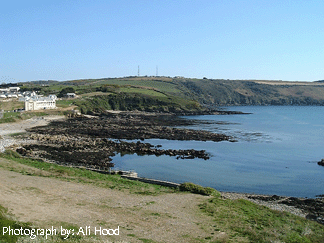
50 21.45N
04 08.07W
50 21.14N
04 07.93W
| Rum Bay | ||
| Lat/long |  |
|
| 50 21.46N 50 21.45N |
04 07.72W 04 08.07W |
|
| 50 21.27N 50 21.14N |
04 07.42W 04 07.93W |
|
| Location description (1957) | |
| This term is used as a general name for the shore between Batten Breakwater and Jennycliff Bay, including both the Batten Bay and Little Pool Bay of the Admiralty charts. Here the tidal zone is broad, exposing an expanse of rock lying mainly below mid-tide level. At the western end the rock is of limestone, which gives place abruptly, under the present R.A.F. station, to shale rock of the same geological period (Middle Devonian). This rock dips seawards, forming ridges parallel to the coast, and these are intersected by gullies. The laminated rock readily splits (except in some patches where quartz veins are numerous), and a multitude of crevices of varying size and depth are formed between the laminae. These provide shelter for a characteristic fauna some members of which fail to colonize the limestone rocks. Broken slabs of rock lying on the ground, numerous in places, provide shelter for a variety of both encrusting and free moving animals. In depressions amongst the rocks the ground is very stony, but some stretches of muddy gravel and a little sand are exposed near low water. In the upper part of the shore are stretches of pebbly beach. The rocks are well covered with species of Fucus, Ascophyllum nodosum, and Laminaria digitata in their respective levels; there is less suitable substratum for Pelvetia and Pygmaea (Lichina), but both occur on the upper rocks; while at extreme low water springs there is now a broad expanse of Laminaria ochroleuca. Among other brown weeds Laminaria saccharina and Himanthalia are frequent, while red algae are well represented. The lower parts of the rocks are well colonized by the usual shore gastropods of the district (Littorina neritoides, L. saxatilis, L. Iittorea, L. Iittoralis, Monodonta lineata, Gibbula umbilicalis, G. cineraria, Calliostoma zizyphinum, Nucella lapillus, Ocenebra erinacea). The overhanging ledges of rock, especially where shaded, give shelter to colonies of encrusting sponges (Hymeniacidon perleve, Halichondria panicea and Grantia compressa), compound ascidians (Dendrodoa, usually dominant, and Botryllus) and polyzoans (Umbonula verrucosa, Crisia). Amongst these growths occur browsing Archidoris britannica, Aeolidia papillosa and Goniodoris nodosa, the polychaetes Eulalia viridis and Nereis pelagica, etc. A full list of the animals living intertidally, or that can at least occur at low water, on this stretch of shore would be long. Most are closely associated with particular micro-habitats or "niches". Thus on the fronds of fucoid weeds the hydroid Dynamena pumila, the polyzoans Flustrella hispida and Membranipora pilosa, and the serpulid worm Spirorbis borealis occur in quantity; and, on the Laminaria, patches of Membranipora membranacea, and browsing individuals of the gastropod Patina pellucida. Clava squamata may be found on Ascophyllum. The rock-crevice fauna includes some of the characteristic species mentioned below (under Wembury). In narrower crevices, at a level above mid-tide, the small nemertine worm Prosorhochmus claparedi lives alongside the pulmonate Leucopepla bidentata, the collembolan Anurida maritima, and other representatives of land groups. Lower down the shore the polychaete Terebella lapidaria is a characteristic species, and amongst other worms are Amphitrite gracilis, Polydora flava, Potamilla reniformis, and Golfingia (=Phascolosoma) minuta. In the low-water region galleries of Marphysa sanguinea are fairly numerous, the worms attaining a large size and sometimes accompanied by the small commensal Harmothoe marphysae. In places at extreme low water Pholas dactylus, Barnea parva, and Pholadfdea loscombiana bore into the shale rock. The old galleries provide shelter for the isopod Cymodoce truncata. Patches of gravel and coarse sand contain at the higher levels Audouinia tentaculata in large numbers, and the intermediate and lower zones are characterized by large Nephthys caeca, Sthenelais boa, Perinereis cultrifera, and Glycera convoluta. Some sand in Little Pool Bay provides settling ground for Arenicola marina, but a former productive patch of sandy ground under Batten Castle, referred to in the older records, virtually disappeared early in the century. In the middle shore, above low water neaps, stones lying on a bottom containing black mud are a typical resort of the leptostracan Nebalia bipes. Stones and small boulders on cIeaner ground, particularly in the lowest part of the tidal zone, yield a great variety of animals, of which only a few can be mentioned. The lower face of such stones is usually thickly coated with encrusting forms, including Spirorbis pagenstecheri, calcareous polyzoans, sponges such as Leuconia and Adocia, etc. The globular protozoan Allogromia oviformis also settles on the lower surface, as do several larger organisms, among which the starfish Asterina gibbosa, the scale worms Lepidonotus squamatus and Lagisca extenuata, the crab Porcellana platycheles, and the tectibranch Berthella plumula may be mentioned. Stones also provide permanent shelter for the amphipods Marinogammarus obtusatus, Pherusa fucicola, Maera grossimana, Melita palmata and hergensis, the isopod Idotea neglecta, the squat-lobster Galathea squamifera, and the brittle-star Amphipholis squamata. In silty gravel under stones are found the irregular burrows of Arenicola ecaudata and branchialis. Nemertines are represented by Lineus longissimus. Larger boulders and the more open crevices provide cover for several crabs --Carcinus maenas, Portunus puber, Cancer pagurus, Xantho incisus, X. pilosus, and Pilumnus hirtellus; and for the familiar shore fishes Gobius paganellus, Blennius pholis, Nerophis lumbriciformis, Lepadogaster gouani and Onos spp. Gobies and blennies deposit their spawn in these situations. |
| Updated information | Description updated in 1999 |
| Species List | >Homarus gammarus |